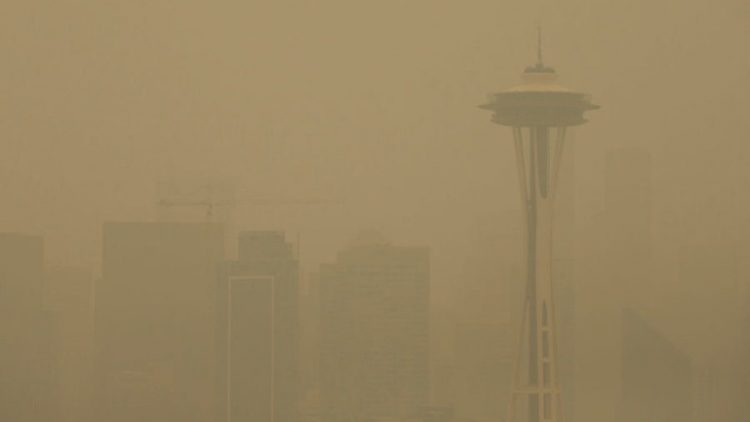June 13, 2023
Protect yourself from poor air quality

Smoke from wildfires obscure the Space Needle and the Seattle skyline on Sept. 12, 2020. (Photo by Lindsey Wasson/Getty Images)
Wildfire season is upon us, and though the air quality in the Pacific Northwest is at safe levels most of the time, many will remember our dubious honor last October when Seattle had the worst air quality in the world and want to be prepared.
When to stay inside: If the air smells like a wood fire, if you can see a haze outside your window or if the sky looks an unusual color (orange, yellow or red), remain indoors.
According to environmental health researcher Savannah D’Evelyn, a postdoctoral fellow with the UW Department of Environmental and Occupational Health Sciences, wildfire smoke doesn’t cause an onset of new disease. However, particulate matter in the air can make existing health conditions, such as asthma and cardiovascular disease, much worse in some people.
Wildfire smoke contains tiny, lightweight particulates that can travel substantial distances—including deep into our lungs and bloodstream where they can exacerbate inflammation, heart attacks, strokes, asthma and other breathing issues. The gases from smoke, including carbon monoxide,
A 2021 study conducted by the Scripps Institution of Oceanography found that wildfire smoke can be up to 10 times more harmful to human health than pollution from car exhaust.
While inhaling smoke is not good for anyone, many people are especially sensitive to smoke inhalation and should be especially cautious, including those with lung diseases, those with respiratory infections, those with prior history of heart attack or stroke, older adults and children.
The Centers for Disease Control has a list of symptoms to look out for:
- Coughing
- Trouble breathing normally
- Stinging eyes
- A scratchy throat
- Runny nose
- Irritated sinuses
- Wheezing and shortness of breath
- Chest pain
- Headaches
- Asthma attacks
- Tiredness
- Fast heartbeat
People with low income are also particularly vulnerable they are more likely to have higher exposures and are less likely to have access to healthcare or to be able to afford interventions to reduce exposure.
Protect yourself from poor air
Limit duration and intensity of outdoor physical activity. If you must be outside, consider wearing a fitted particulate respirator mask, such as an N95. Check out the Air Quality and Outdoor Activity Guidance for Schools from Air Now, a program of the Environmental Protection Agency.
Minimize your exposure indoors: Close all doors and windows to the outside. If you have central AC, run it to utilize the filter.
If you’re in the car, be sure to use your recirculate function.
Filter indoor air through an HVAC system, HEPA portable air cleaner, or DIY box fan filter.
- Avoid burning candles, incense, and wood in fireplaces.
- Avoid using sprays, diffused essential oils, and fireplaces.
- Avoid broiling or frying food and limit use of gas stoves.
- Avoid smoking indoors.
How to find out current air quality
Check current and forecasted wildfire and smoke locations on the Washington Smoke Information website (the Smoke Blog) or on WA Ecology’s Washington Air Monitoring Network.
- The Washington Air Quality Guide for Particle Pollution (PDF) graphic provides health recommendations for the different color-coded air quality categories based on EPA’s Air Quality Index (AQI).
Understanding the AQI
The higher the AQI value in your area, the greater the level of air pollution and the greater the health concerns.

AQI of 100 or below represents good air quality and won’t pose risks.
AQI between 101 to 150 means people with respiratory or other medical issues should start taking precautions like avoiding the outdoors altogether or wearing a mask when outside.
AQI between 151 to 200 means most people will start noticing some minor effects like a scratchy throat, runny nose and maybe some nausea.
AQI between 201 to 300 means health risks are increased for everyone, whether you have underlying issues or not.
AQI of 301 or above means everyone will likely experience some form of smoke-related health issue. If you can, move all activities indoors or reschedule them for another day.
Support
Fire season highlights the incredible work of firefighters and environmental protection organizations. Consider setting up monthly payroll deduction or making a one-time gift to any of the following UWCFD member organizations working to mitigate the effect of wildfires in our region:
UW Forest Resources Scholarship Fund (charity code 1480131): To provide support for students enrolled in the School of Environmental and Forest Sciences.
Washington State Fire Fighter’s Association (charity code 0518389): The Washington State Fire Fighters’ Association provides information education benefits and representation to the volunteer fire service of the State of Washington in order to enhance their capabilities and professionalism.
The National Forest Foundation (charity code 1478546) works on behalf of the American public to inspire personal and meaningful connections to our National Forests, the centerpiece of America’s public lands.
The American Forest Foundation (charity code 1478546) works on-the-ground with families, teachers and elected officials to promote stewardship of and protect our nation’s forest heritage.
The Soup Ladies (charity code 1481469): Our mission is to provide fresh cooked meals expeditiously to support first responders such as police and fire departments, search and rescue teams and military personnel in times of emergencies and disasters.
Contributed by Nicole Reeve-Parker